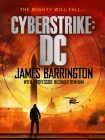Cyberstrike by James Barrington (best english books to read .txt) 📗

- Author: James Barrington
Book online «Cyberstrike by James Barrington (best english books to read .txt) 📗». Author James Barrington
‘Where are you taking the suspect?’ Dave North asked.
‘Initially they’ll bring him here to Wapping so we can process him, but I’ve already had Five on the line so I guess he’ll be transferred to Millbank or maybe to Paddington Green for questioning. But that decision is above my pay grade.’
Dame Janet ended the call and glanced around the table. ‘Assuming this isn’t a case of hopelessly mistaken identity and some waterborne rozzer seeing something that quite literally wasn’t there, I think we can say that we’ve been lucky. More importantly, Parliament has been lucky, and that doesn’t happen very often. Dave, this is more your department than anybody else’s, so get yourself out to Wapping, take a look at this character and whatever evidence the MPU manages to drag out of the Thames and then let me have your assessment.’
North nodded. ‘There may not be all that much to find,’ he said, ‘because if that was an IED that these two managed to cobble together, the most likely explosive for them to have used would be ammonium nitrate and that’s highly hygroscopic, meaning it attracts water. If you put it in enough water, and I promise you there’s definitely enough in the Thames, it can turn to liquid. Can you call back the guy at Wapping and tell him to make sure that the people on the scene recover at least a sample of whatever was inside that plastic if they can’t get the whole thing out of the water?’
‘No problem,’ Dame Janet replied. ‘Now get on your way. I want to know what’s going on as soon as possible. And why are you still here, Ben?’ she asked, swivelling her attention to Morgan. ‘Cyber stuff and cyberattacks are potentially a much bigger problem than a couple of terrorists in a stolen cabin cruiser, so get moving.’
Chapter 17
London
Like almost all the great cities of the world London is built on a river but, unlike most other cities, it is also to some extent divided by the tidal waterway that runs through its heart. With few exceptions, the ‘best’ districts in the capital city, areas with names like Belgravia, Chelsea, Knightsbridge, Mayfair and of course Westminster, the seat of the government of the United Kingdom, are all located on the northern side of the river. In this half of London, property prices are higher, the buildings are more elegant and the streets always seem to be wider and cleaner and prowled by more expensive cars.
To the south, the names resonate less well: districts like Brixton, Clapham, Croydon and Peckham, the last achieving enduring fame as the location of a perennially popular television comedy series that seemed to encapsulate the hand to mouth, cash-based, quasi-legal economy of one of the poorer sectors of the capital’s population. And many of these areas enjoy less than savoury reputations. In the past cab drivers were known to demand a higher fare if they had to venture ‘south of the river’ and especially if it was a late evening or night-time journey.
Those organisations and businesses that did, for whatever reason, establish themselves on the southern side of the Thames seemed almost unwilling to venture too far away from the river, clustering as close as they could to the waterway. The headquarters of the Secret Intelligence Service, popularly and incorrectly known as MI6, the building commonly referred to throughout the intelligence community as ‘Legoland’ and by certain other less polite epithets, demonstrates this perfectly. It’s located at the south-eastern end of Vauxhall Bridge and if it was any closer to the river it would actually be in the water.
But not everywhere north of the river enjoys the wealth and kudos of a district like Mayfair, and a good example is the north-east London suburb of Stratford, part of the old parish of West Ham. It’s been inhabited for the better part of a thousand years; the name Strætforda, a compound place name deriving from the Old English stræt or ‘street’ and ‘ford’ and referring to a river crossing, its exact location unknown but somewhere north of the present Stratford High Street, being recorded as early as 1067. The area began the twentieth century in a state of economic decline that continued to worsen with every passing decade. De-industrialisation had ended the district’s importance as a manufacturing centre, as a major railway hub and as London’s principal commercial dock area.
Then, on 6 July 2005, London was announced as the venue for the 2012 Summer Olympics, and what happened after that changed Stratford permanently. Because of the need to not only create world-class sporting facilities in the area but also to improve and update roads and transport links, and in some cases to create brand new ones, Stratford received an astonishing level of expenditure, totalling almost £10 billion, making the London Olympics the third most expensive games ever held after Beijing 2008 and Sochi 2014.
Leyton Grange Estate isn’t a part of Stratford but of the much larger borough of Waltham Forest. It lies north-west of the A12 that forms the northern boundary of Stratford, and north-east of Hackney Marshes, and is a primarily residential London suburb. The modernisation and gentrification of Stratford inevitably had an effect upon the surrounding areas, and despite the sometimes unfortunate connotations of the word ‘estate’ when applied to urban housing, the Leyton Grange Estate is a popular area to live for both owners and renters. Most of the older properties are solidly built mainly Victorian terraced houses, originally intended for single family occupation but in some cases now divided up into two or three flats to maximise their rental potential and overall property value, or converted into HMOs, houses in multiple occupation,





Comments (0)